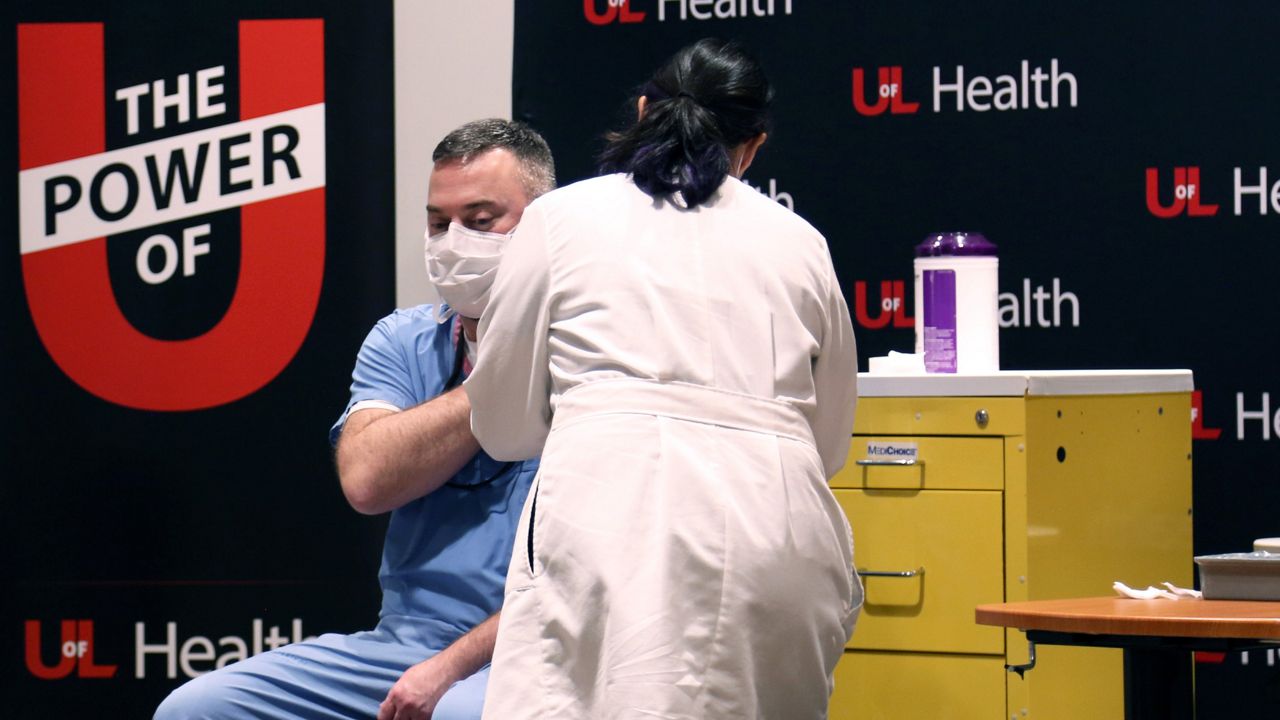LOUISVILLE, Ky. — Governor Andy Beshear is not pleased with the pace of Kentucky’s COVID-19 vaccine rollout.
“We have too many people out there that are rightfully anxious and we need to see the whole country pick up the pace,” he said in his Monday press briefing. “We’re certainly going to do it here in Kentucky.”
So far, Kentucky has administered 77,349 vaccinations, according to the state’s tracking website, which was last updated Wednesday. That’s well behind neighbors Ohio (221,302 vaccines administered), Indiana (128,026 vaccines administered), and Tennessee (169,070 vaccines administered).
As a percentage of its population, Kentucky has vaccinated similar numbers to Ohio and Indiana, but all three states trail Tennessee. Kentucky also lags its neighboring states by another measure of vaccination progress. According to Bloomberg, Kentucky has used 38.9 percent of the vaccines distributed to the state, behind Ohio (48.8 percent) and Tennessee (51.5 percent), but ahead of Indiana (36.1 percent).
“We’re going to be pushing harder and harder and harder to get these vaccines into people’s arms so much faster,” Beshear promised Monday.
That’s already happening at one vaccination site in Louisville, said Dr. Jason Smith, chief medical officer of UofL Health.
“Almost never base your overall projections on the first two weeks of anything like this,” he said. Smith said many processes had to be put in place between the arrival of the first vaccines and the quick administration of the shots.
“We've got new IT systems that we were putting in place to monitor and track this,” he said. “We've got an immense amount of reporting required by both federal and state governments.”
Those systems are now in place, Smith said, and he’s now reached a point where all he has to worry about is getting syringes into arms. “It just takes a little bit of time to get some of those things in place,” he said.
The arrival of both the Pfizer and Moderna vaccines during the holiday season made it take even longer. Not only did that unfortunate timing delay the implementation of the necessary systems, it also pushed back the vaccinations of some health care workers. Smith said some UofL health workers chose not to go into work to be vaccinated on Christmas Eve and Christmas, waiting until the next work days instead. “I don’t blame them,” he said.
Kentucky Public Health Commissioner Dr. Steven Stack also said the timing of the vaccine arrival contributed to the slower-than-ideal rollout.
“You can’t underestimate the impediment it was to have so much new stuff, so much uncertainty in quantities, new data systems, end of the year major holidays and an exhausted health care workforce — all of this coming together in the first two weeks of the rollout,” he said Monday.
The chaos of the rollout has been revealed in situations like the one that played out at several Louisville Walgreens pharmacy stores in late December. According to Beshear, some locations of the store had more vaccines available than patients to give it to, so they vaccinated members of the general public. “When we look at deploying millions of vaccinations across Kentucky in the coming months, there’s going to be mistakes,” he said.
These problems were not unique to Kentucky. The federal government set a lofty goal of injecting 20 million people with their first dose of a COVID-19 vaccine by the end of 2020. The country fell 18 million vaccinations short.
As the year ended, Moncef Slaoui, chief adviser to Operation Warp Speed, admitted that the number is “lower than what we had been hoping for.”
But he also said the responsibility to get vaccines where they need to be is the responsibility of the states. President Trump said the same in a tweet on December 30. “The Federal Government has distributed the vaccines to the states,” he wrote. “Now it is up to the states to administer. Get moving!”
President-elect Joe Biden has been critical of the federal government’s role in the vaccine rollout. In a speech last week, he said, at the current pace, it would be "years, not months" before America could achieve herd immunity.
"I've directed my team to prepare a much more aggressive effort, with more federal involvement and leadership to get things back on track," Biden said. "This is going to be the greatest operational challenge we've ever faced as a nation, but we're going to get it done."
In explaining the pace of vaccines in Kentucky, Beshear turned attention back on the federal government, saying it underestimated the amount of time each vaccination takes and the number that could be administered by one health care official. He also called for more mass vaccination sites, like the one that opened at Louisville’s Broadbent Arena this week.
That site is expected to administer 1,000 doses of the Moderna vaccine this week, and ramp up 1,000 doses a day. Smith said UofL Health is on pace to vaccinate its entire staff — between 12,000 and 13,000 people — by the end of January. After that, he expects to administer 1,000 vaccines per day to the next people in line. “We've got a lot of capabilities, it's just a matter of getting the vaccine to us, and giving us a chance to get it out,” he said.



